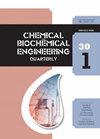吸附水中腐殖酸的钴基金属有机骨架的合成及应用
IF 0.9
4区 生物学
Q4 BIOTECHNOLOGY & APPLIED MICROBIOLOGY
引用次数: 2
摘要
研究了腐殖酸在钴基金属有机骨架(Co-MOF)上的吸附行为。采用溶剂热法合成了Co-MOF,并利用X射线衍射(XRD)、傅立叶变换红外光谱(FTIR)和扫描电子显微镜(SEM)对其进行了表征。材料的表征结果证实了MOF结构的形成。通过批量实验获得实验吸附数据,还研究了吸附动力学、等温线、热力学以及等温吸附热。在pH 6和305 K下获得了~91 mg g–1的最佳吸附量。实验结果的回归分析表明,吸附动力学遵循准二阶动力学模型,吸附可以在~20分钟达到平衡。吸附等温线数据可以很好地与Koble-Corrigan等温线拟合。热力学参数表明,腐殖酸的吸附是一个自发的、吸热的物理过程,而等温评价揭示了吸附剂的非均相性质。总的来说,Co-MOF是一种很有前途的吸附水中腐殖酸的选择。本文章由计算机程序翻译,如有差异,请以英文原文为准。
Synthesis and Application of Cobalt-based Metal-organic Framework for Adsorption of Humic Acid from Water
In this study, the adsorption of humic acid on cobalt based metal-organic framework (Co-MOF) was investigated. Co-MOF was synthesized via solvothermal technique and further characterized using X-ray diffraction (XRD), Fourier transform infrared spectros-copy (FTIR), and scanning electron microscopy (SEM). The characterization results of material confirm the formation of MOF structure. The adsorption kinetics, isotherms, thermodynamics, as well as isosteric heat of adsorption were also investigated by obtaining experimental adsorption data through batch experimentation. Optimum adsorption uptake of ~91 mg g –1 was attained at pH 6 and 305 K. Regression analysis of experimental results revealed that adsorption kinetics follows a pseudo-second-order kinetic model, and adsorption can reach equilibrium at ~20 min. Adsorption isotherm data can be well fitted with Koble Corrigan isotherm. Thermodynamic parameters demonstrated that the adsorption of humic acid is a spontaneous, endothermic, and physical process, while isosteric heat evaluations revealed the heterogeneous nature of the adsorbent. Overall, the Co-MOF was a promising choice to adsorb humic acid from water.
求助全文
通过发布文献求助,成功后即可免费获取论文全文。
去求助
来源期刊
CiteScore
2.70
自引率
6.70%
发文量
23
审稿时长
>12 weeks
期刊介绍:
The journal provides an international forum for presentation of original papers, reviews and discussions on the latest developments in chemical and biochemical engineering. The scope of the journal is wide and no limitation except relevance to chemical and biochemical engineering is required.
The criteria for the acceptance of papers are originality, quality of work and clarity of style. All papers are subject to reviewing by at least two international experts (blind peer review).
The language of the journal is English. Final versions of the manuscripts are subject to metric (SI units and IUPAC recommendations) and English language reviewing.
Editor and Editorial board make the final decision about acceptance of a manuscript.
Page charges are excluded.

 求助内容:
求助内容: 应助结果提醒方式:
应助结果提醒方式:


